|
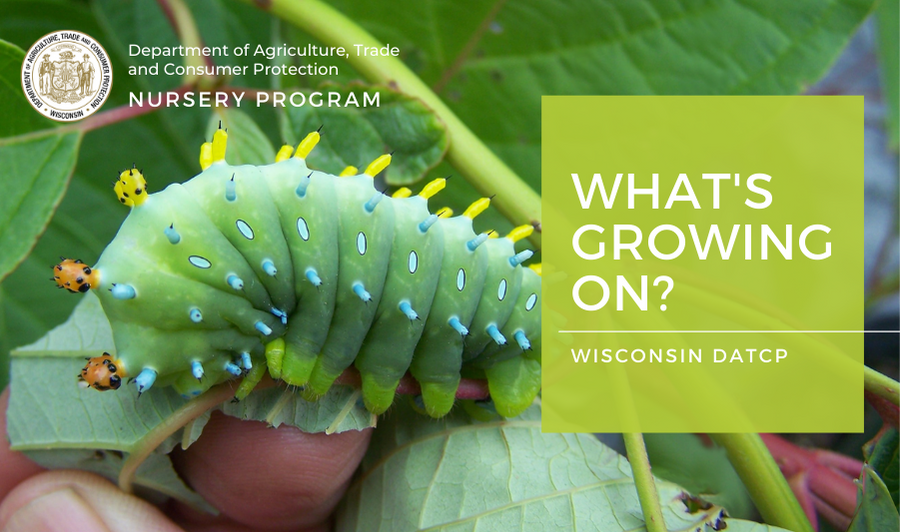 _____________________________________
Dear Wisconsin nurseries, Christmas tree growers, and gardeners:
Growing degree days (GDD)(simple B50) as of July 14 were 698 in Bayfield, 961 in Cumberland, 884 in Medford, 1103 in Hancock, 1208 in Green Bay, 1384 in Racine, 1381 in Madison, 1324 in La Crosse and 1578 in Dubuque, IA. A few pests in vulnerable-to-treatment stages include black vine weevil, European pine shoot moth, oak spider mite and boxwood psyllid at 900-1000 GDDs; two spotted spider mite at 900-1100; and cottony maple scale, European elm scale, fletcher scale and lecanium scale at 900-1200 GDDs. Other pests soon to be in vulnerable stages include flat-headed and round-headed apple tree borer and pine needle scale at 1600-1700 and locust borer and fall webworm at 1800-2100 GDDs.
Please send any feedback, questions, or ideas for future e-news updates to datcpnursery@wisconsin.gov.
Having trouble viewing this email? View it as a Web page.
_____________________________________
|
|
|
Spotted Lanternfly and its lookalikes | Graphic by the Missouri Department of Agriculture
The spotted lanternfly (SLF), an invasive plant pest that feeds on a variety of plant species, continues to make its way closer to Wisconsin. Preventing the introduction of this insect into the state requires monitoring of at-risk areas. Locations are deemed at-risk based on their proximity to out-of-state traffic and shipments. Some examples of at-risk locations include garden centers, travel plazas, malls, college campuses, ports, and campgrounds. When visiting these locations in Wisconsin, keep an eye out for SLF and report anything suspicious!
The spotted lanternfly (Lycorma delicatula) has multiple life stages, each with its own unique appearance. Nymphs, hatching in late spring, are the first stages of the insect’s life and are less than ¾ inch in length. They are rounded and begin black in color with white spots, eventually becoming red with white spots. Adults emerge in late summer and are roughly one inch in length. At rest, they are tan or gray with black spots, only showing their bright red underwings when in flight.
Spotting SLF among all the lookalikes can be tricky, with many native insects having similar colorations and patterns. Insects like the red milkweed beetle and milkweed bug have red coloration similar to SLF nymphs but lack rounded bodies and white spots. Similarly, insects including cicadas and tiger moths have similar shapes to adult SLF but lack wing spots. For more information on the many spotted lanternfly lookalikes, check out this guide.
_____________________________________
|
|
|
As temperatures warmed this spring, the Wisconsin Spongy Moth Hotline started receiving numerous reports of spongy moth (Lymantria dispar) caterpillars hatching in “biblical proportions.” These invasive insects have a seemingly insatiable appetite for leaves and can strip the trees bare when caterpillar populations are large enough. Large scale population outbreaks like this are known to occur approximately every decade. Peak populations, like we are currently experiencing, typically last for two to three years but eventually decline under the right conditions. Luckily, many parts of Wisconsin appear to be experiencing those “right conditions” in 2024, and may see declines in spongy moth populations due to a rise in two naturally-occurring diseases.
|
|
 Spongy moth larva dead from NPV infection | DATCP image
|
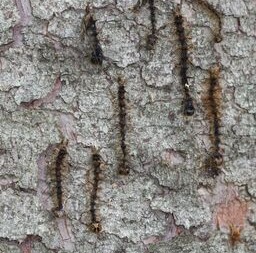 Spongy moth larvae dead from E. maimaiga infection | USDA-FS Steven Katovich, Bugwood.org)
|
|
|
The nucleopolyhedrosis virus, or NPV, thrives in areas with a high density of spongy moths. Caterpillars that die of NPV hang in an upside-down “v” shape. Entomophaga maimaiga is a fungus that spreads easily in wet weather. When caterpillars die of this fungal infection, their bodies look shriveled, dark, and straight. The combination of a wet spring and summer and large residual spongy moth populations from the previous year are creating a high potential for these diseases to impact spongy moth populations in 2024. Although preliminary reports indicate these diseases are prevalent in several areas throughout Wisconsin, more information on their location and severity will help track areas where spongy moth populations may be in decline. If you see spongy moths exhibiting symptoms of either of these infections, please report your observation at https://arcg.is/ni4eu.
Growers and landowners concerned about spongy moth damage are encouraged to survey their property for egg masses starting in late summer through the fall to assess the need for further management actions. Areas with high rates of the diseases described above may see fewer new egg masses this year and less spongy moth defoliation damage in 2025. More information on spongy moth lifecycles and control can be found on the Wisconsin Spongy Moth Resource Center online at spongymoth.wi.gov. Any questions can be directed to the Wisconsin Spongy Moth Hotline at (800) 642-6684 or datcpspongymoth@wisconsin.gov.
_____________________________________
|
|
|
Did you know there are 20,000 species of bees in the world, with approximately 4,000 living in the United States and 400 species here in Wisconsin? Bees vary in color, size, life cycles, and even their ability to sting. About 98% of our bee species are solitary, which means that they live alone with the female provisioning the nest, laying and caring for her brood, and foraging. Native bees often build their nests in small holes in the ground or varying sized plant stems and are easy to overlook. Social bees and wasps are not as easy to ignore, with their nests ranging from 50 individuals (some bumble bee species) to over 60,000 individuals in our honey bee colonies during the middle of summer.
Eighty percent of the world's flowering plants are pollinated by animals that include bees, wasps, flies, moths, beetles, hummingbirds, and even bats in some parts of the country. Wasps, flies, and moths can often be mistaken for bees, so here are some tips on telling the difference between similar(ish) Yellow and Black Insect Groups:
-
Yellowjacket wasps vs. honey bees. Evolution caused these two cousin species to diverge based on their diets, with one being a "plant eater" and the other being a "meat eater". Yellowjacket wasps are the meat eaters and are important predators of our garden pests. Both are pollinators and social insects, meaning they live in a colony with one queen, female workers, and non-stinging male drones. Yellowjacket wasps nest in the ground or open-faced paper nests that begin formation in early spring. Their nests often go unnoticed until August when the colony starts producing males and new queens for the next season. This means the whole nest dies by the second hard frost. They do not use the same nest the following season. Honey bees, the plant eaters, although not native to Wisconsin, are highly beneficial pollinators whose colonies can successfully overwinter and live many years, if properly managed.
-
The Cicada killer wasp vs. northern giant hornet. Both can appear to be very large and scary, but the cicada killer wasp is actually a zero on the danger scale. She is a solitary wasp, native to Wisconsin, living in her ground nest using her stinger almost exclusively to paralyze and feed cicadas to her larvae. The northern giant hornet may seem like a 10 on the danger scale, but that is not for us to worry about since they are currently not in Wisconsin or the United States, as populations were recently eradicated from Washington state. Northern giant hornets have a bright yellowish-orange head, a dark body, and alternating dark and yellowish stripes on the abdomen.
-
Bald-faced hornet vs. yellow-legged hornet. All hornets are wasps, but not all wasps are hornets, and this is true for bald-faced hornets. Bald-faced hornets are actually "aerial yellowjackets" and in true yellowjacket fashion, they build their grey papery nests in bushes and trees and bravely defend it. They are also great predators of garden pests and help keep other insects at bay while pollinating flowers in their search for nectar. The yellow-legged hornet, if established in the United States, could threaten populations of domestic honey bees and native bees, as well as disrupt crop pollination. These hornets are slightly bigger than bald-faced hornet workers. They are mostly black or dark brown in color, with some orange or yellow, and lack the classic white color of the bald-faced hornets. Populations of yellow-legged hornets detected in Georgia in 2023 are currently being eradicated by state officials. Yellow-legged hornets have never been detected in Wisconsin.
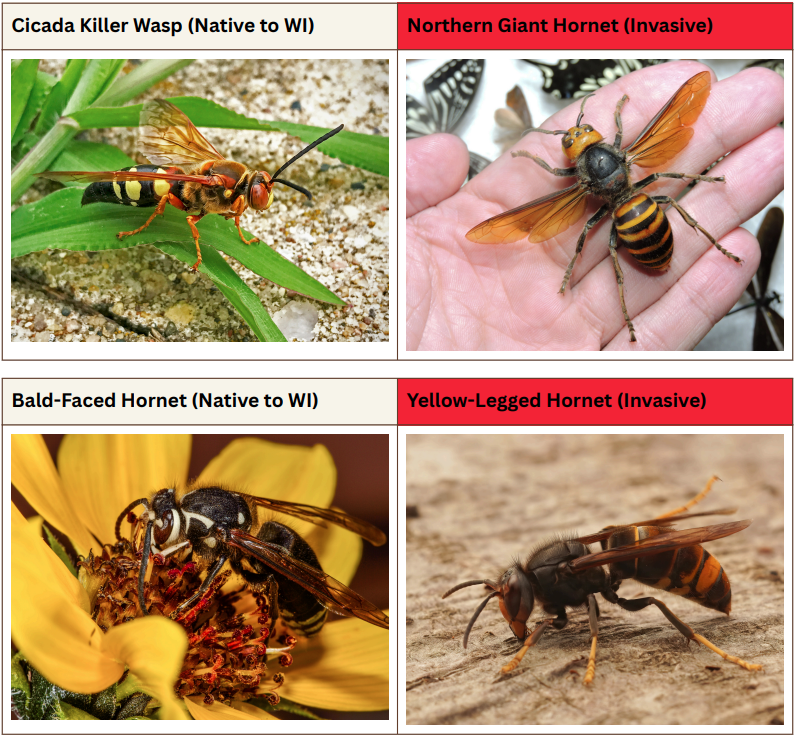 Native insects like the Cicada Killer Wasp or the Bald-Faced hornet are often mistaken for invasive pests like the Northern Giant Hornet and Yellow-Legged Hornet | DATCP B. Nikkila-Sommerfeldt
Now that you know some of the differences between similar-looking invasive and native insects, here are some additional considerations:
- Observe the insect's behavior. If it’s on a flower, it’s foraging and not planning an attack.
- Are you near its nest? Can you live with each other until the second hard frost when the colony or individual will naturally die off?
- Take a few clear photos (yes, it’s hard to take a clear photo of a flying insect) or short video and send it to us at datcpapiary@wisconsin.gov and we can help you identify it.
- If you believe you have detected Northern Giant Hornet, Yellow-Legged Hornet, or another invasive species not known to be present in Wisconsin, please take a picture and report it on our Pest Hotline at datcppesthotline@wi.gov or (866) 440-7523.
-Article originally published in the July issue of the DATCP Apiary Program Newsletter
_____________________________________
|
|

As shipping across both the country and the world becomes more important to the nursery industry, the rising volume of shipments has made controlling plant diseases and pests more challenging than ever. As part of the efforts to manage this challenge, the National Plant Board and its partners in government and the green industry worked together to develop a Systems Approach to Nursery Certification (SANC). SANC is a national voluntary program that uses an audit-based system to safeguard plant health. This program has been in development since 2010, but formally started with a pilot phase of eight nurseries across the country in 2014. The goal of SANC is to use a more wholistic approach to manage plant health at all stages of production based on strong production practices.
The process of SANC enrollment is dependent on a series of steps that achieve these safeguarding goals. First, the participating nursery facility identifies the aspects of production that are potential entry ways for pests and diseases. These are called critical control points. This could mean anything from the source of plant material to watering systems to employee guidelines. Facilities also work on developing management practices that address these critical control points, and the potential pest species associated with them. The other major components to SANC are documentation and record keeping. By writing down and standardizing the methods used, a facility can ensure that they are consistent, and by keeping careful records, facilities can trace identified issues to their source. All these steps come together in a SANC manual for the facility. This manual has four sections:
- The pest management plan, which details the critical control points and the management practices associated with them
- Staff and facility, which details the duties of staff related to SANC and the overall facility description
- Audits, which details how audits are conducted
- Documentation, which details what kinds of records should be kept
What SANC means in practice is that a production facility will have the framework in place to monitor for and act on plant health issues that arise. To ensure that is the case, audits are performed by both the facility and by DATCP nursery inspectors. There are two different kinds of audits preformed: surveillance audits, which focus on a specific aspect of production, such as disease management or record keeping; and the full systems audit, which evaluates all the facilities’ activities against those described in their manual. If discrepancies are found during an audit, a notice is made to the facility and a timeline for corrective action is established. These safeguards help ensure that plant health is maintained consistent with SANC standards.
Wisconsin currently has one nursery in the SANC program: Agrecol. Agrecol specializes in Midwest native prairie plants, including herbaceous perennials, grasses, and sedges, and has been part of the SANC program since 2019.
|
_____________________________________
|
|
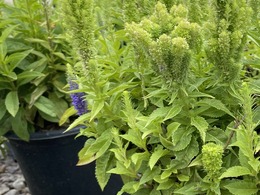 Aster yellows on speedwell in Dodge Co. | DATCP L. Meils
|
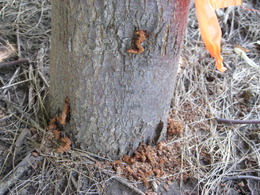 Frass from Linden borer larvae infesting linden in Rusk Co. | DATCP image
|
|
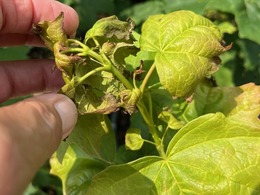 Leafhopper feeding damage on maple in Waukesha Co. | DATCP M. Wensing
|
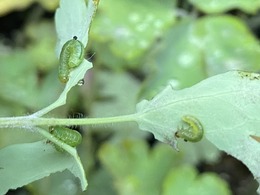 Columbine sawfly larvae on columbine in Waushara Co. | DATCP L. Meils
|
|
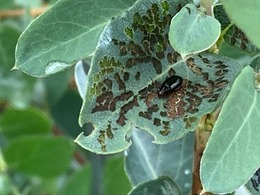 Red headed flea beetle and feeding damage on snowberry in Waukesha Co. | DATCP M. Wensing
|
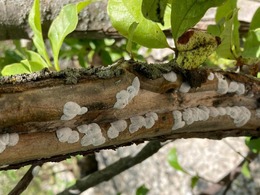 Magnolia scale on magnolia in Kenosha Co. | DATCP G. Meysembourg
|
|
|
_____________________________________
|
|
|
|
|